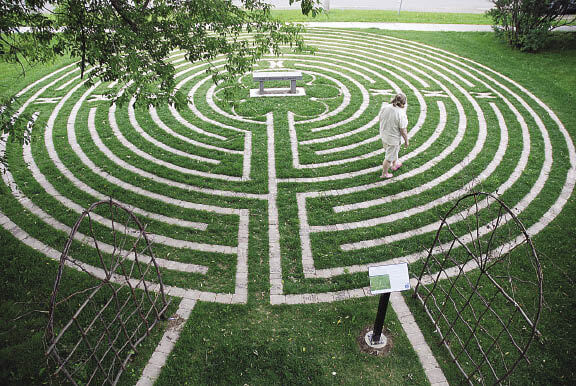Learn How to Meditate While You Walk

There are people who never learn to meditate. The mind does not tune itself to the motionless calm while practicing mindfulness, or while getting into a deep state of calm by quietness. However, something as easy as beginning to walk can turn your life around.
We have already talked in this blog about how therapeutic practices, such as mindfulness, may not be useful for everyone. Teens or even people with high levels of anxiety, who suffered some type of trauma, are not able to achieve that perfect point of relaxation by learning to be more aware of their inner world through a relaxed state.
“Walking is worth it even if you fall.”
– Eduardo Galeano-
If the mind shouts, when our thoughts are obsessive there is a strategy that hardly ever fails: walking. In fact, there is something magic in the simple act of walking. The motion of our body is like the beat of a moving metronome. A perfect rhythm that sooner or later tunes our mind into a single entity. A unique melody.
With each step the heart expands, the breathing becomes deeper, resounding. The brain oxygenates itself. Our being enlarges with those repetitive movements until it finds his break-even point, while taking control of our own life through the combination of this physical exercise and meditation.

Meditating while we walk: A gratifying means to an end
When a psychologist decides to integrate mindfulness into psychotherapy, he/she does not seek to turn his patients into skillful spiritual meditators. He/ She does not want to convince them to spend their weekends in Buddhist silent retreats. Not at all. It is a means to an end. A tool for them to live their lives in equilibrium and with an more settled consciousness.
Meditation demands responsibility and will power. If it is not easy to isolate the sound of our surroundings and the roar of the cities, it is even harder to quiet the mind. That is why today, the application of this new path can be summarized into a single illustrative Sanskrit word “apranihita”, meaning walking without arriving. Beginning to walk without having a concrete destination allows us to truly enjoy the simple movement. We walk for the pleasure of walking.
The human mind is similar to a restless monkey, constantly jumping from branch to branch in a chaotic, nervous and unproductive journey. Almost without knowing how, we end up lost in our own mazes. Nevertheless, if we manage to soothe that nervousness through the rhythm of our legs and a breathing pattern marked by the cadence of every step, we will be able to consciously control our thoughts.

How to learn to meditate while we walk
We should take daily walks, not exceeding a half-hour. It is important that we walk through nature, in a quiet space. Wearing comfortable shoes and clothing.
Start walking with a normal pace. You should slowly find the rhythm more relaxing, cathartic and liberating to you. There are people who walk in a slow pace while others decide to walk faster.
Center your attention on something. Visualize your mind as if it was a flashlight moving its beam of light on a concrete aspect and then moves to another. First your breathing, then the sensation of your feet while touching the ground, next the wind that touches your skin. Center your attention in those aspects in a cyclical mode, first one and then the other.
You will little by little realize, you no longer need to focus your attention on any of those aspects of your body. After a few days the focus of your flashlight will be very wide. You will perceive everything at once.
Your consciousness has expanded so much that your whole being will be perfect, in total calmness and harmony.
Walking in a labyrinth: The magic of concentration
Let’s go now a little farther. Imagine that in your case, the simple fact of leaving home and walking without a fixed destination will distract you. It will disperse your mind even if you do not seem to find your break-even point, your center, your point of calmness.
The mind can go by thousand addresses.
But on this beautiful path, I walk in peace.
At every step, a soft wind is blowing.
At every step, a flower opens.
In this case we can immerse ourselves in an interesting and ancient practice present in lots of cultures. We talk about traveling a labyrinth. This ancestral practice is similar to visualizing every problem tattooed in the ground. We will go over them step by step while finding a way out. Some of the earliest types of labyrinths are in Greece. Their main purpose was to find meaning to life through those spiral circuits.

It was another type of meditation that until today, is common in many countries. In the labyrinths there is not only one way out. There is no success in finding how to get out of them. The benefit is in the journey itself. In what we get while moving through it.
The objective is to “calm the mind, open the heart” through the exercise itself. When entering a labyrinth stop and reflect. Think of what we should let go before initiating that concentric journey. Focus on the present, the here and now.
Walk slowly. Put one foot in front of the other. Concentrate the gaze, at all times, in the shape of the lines, and on the roads.
Upon arriving at the center or to the labyrinth, what is called “the rosette”, the person should rest and meditate for a couple minutes on the journey itself. The objective of this exercise is not finding the way out of our bundle of problems, but coming out empowered by the knowledge acquired during this process.
This text is provided for informational purposes only and does not replace consultation with a professional. If in doubt, consult your specialist.








